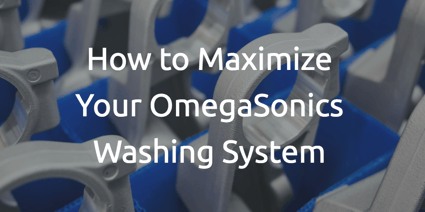 There are a lot of different ultrasonic parts washing machines on the market. Manufacturers like Durr, Crest, Bransahoff, and OmegaSonics each have machines that have numerous differences from one another.
There are a lot of different ultrasonic parts washing machines on the market. Manufacturers like Durr, Crest, Bransahoff, and OmegaSonics each have machines that have numerous differences from one another.
These differences include:
- Chemicals used in the process
- How parts are handled/moved
- Force of the ultrasonic transducer
- Wash temperatures
- Process duration
The list goes on and on.
To get the most out of any ultrasonic parts washing system requires a thorough understanding of that system and what makes it different from the other solutions on the market.
For example, how can you get the most out of the OmegaSonics OMG-5028-X3?
Step 1: Check out the Machine’s Specifications & Features
 This particular machine has three separate stainless steel chambers for washing, rinsing, and then drying parts. The wash and rinse chambers are equal in size, with each one measuring 18” wide, 18” long, and 20” deep. The dry chamber is slightly larger, measuring in at 18” wide, 24” long, and 20” deep, with a rack that lifts loaded baskets about 4” from the bottom.
This particular machine has three separate stainless steel chambers for washing, rinsing, and then drying parts. The wash and rinse chambers are equal in size, with each one measuring 18” wide, 18” long, and 20” deep. The dry chamber is slightly larger, measuring in at 18” wide, 24” long, and 20” deep, with a rack that lifts loaded baskets about 4” from the bottom.
The transducers in the first wash tank operate at about 25 kHz at peak strength—which is a bit more powerful than many ultrasonic cleaning machines.
The default temperature presets for the wash and rinse tanks are 130°F and 150°F, but this can be altered using the machine’s digital temperature controls. The drying chamber uses air heated to up to 180°F to help facilitate drying. The drying temp is capped at this level to prevent water from reaching boil temperature and leaving water marks/residue on parts.
Each of the tanks also has a lid that shuts to prevent contaminants in the air from getting in the wash agents.
Step 2: Design a Parts Container That’s Optimized for Both Your Parts and the Machine
In any ultrasonic parts cleaning machine, it’s important to have a wash basket that is able to hold parts securely without damaging them, and will actually fit inside the machine.
Ideally, this container should:
- Allow some extra room between the container and the walls of the wash tank;
- Minimize interference with the ultrasonic waves;
- Use thicker-gauge wires to withstand ultrasound vibrations;
- Be easy to clean;
- Have handles or hoists that are compatible with your method of moving the container between steps; and
- Be able to resist corrosion from the chemicals used in the wash process when completely immersed for prolonged periods of time.
Each of these design considerations contributes to making the wash process complete faster, ensuring parts get clean quicker, or helping the wash basket itself last longer.
Step 3: Minimize Your Part’s Exposure to Dust After Cleaning
The lidded tanks used by the OmegaSonics ultrasonic parts washer help to ensure that the contents of the washer are isolated from contaminants in the air such as dirt and dust. However, once the parts are finished drying off and being moved to the next process, it’s important to keep that dust and dirt off.
Here, using covers for the containers can be enormously helpful, as they’ll keep parts from being exposed to the majority of dust and other airborne contaminants until they’re ready to be put through final assembly.
Step 4: Maintain the Machine!
Even the best factory automation equipment is only as good as the care that goes into its maintenance. To keep an ultrasonic parts washing machine running at top efficiency, it should be routinely maintained according to the manufacturer’s best practices/guidelines.
For the OmegaSonics DX-3, it’s recommended that a specific cleaning procedure be performed every time the bath is changed.
Keeping the wash tanks clean and free of oil or other contaminants helps to ensure that parts put through the wash process get cleaned right the first time. If the solution used in the cleaning process isn’t changed regularly, then contaminants from earlier wash cycles could be deposited on parts.
Basic maintenance checks for leaks and other issues should also be done when the machine is being cleaned/maintained.
With some effort, and the right parts washing basket design, getting the most out of ultrasonic parts washing machines from any manufacturer can be easy. Find out how you can make your own ultrasonic parts washing process more efficient today!



.gif)


